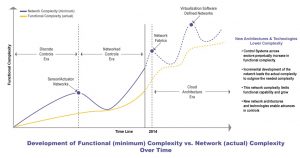 Real-time Ethernet is going to be the next big thing in industrial networking. Seen as a high speed alternative to the serial fieldbus networking protocol in factory automation, robotics and industrial IoT, real-time Ethernet could transform industrial networking by creating combined control and data communications networks.
Real-time Ethernet is going to be the next big thing in industrial networking. Seen as a high speed alternative to the serial fieldbus networking protocol in factory automation, robotics and industrial IoT, real-time Ethernet could transform industrial networking by creating combined control and data communications networks.
As a result it is the focus of a new standards push for robust, synchronised networks.
“Our world communicates over Ethernet, with incredibly fast 10G and 40G networks leading the way. But this isn’t the case in industrial environments, like manufacturing and electrical power grids, that require deterministic communications for distributed control and measurement,” said Neil Stroud, who works in Intel’s industrial products group.
This is about to change with new Ethernet IEEE 802 standards – referred to as time sensitive networking (TSN).
Originally an audio/video interface standard, TSN effectively defines real-time Ethernet communications.
For industrial applications, TSN provides a common, deterministic foundation for various industrial protocols and will ultimately reduce network complexity, decrease networking costs, improve security, and further IT/OT convergence in industrial settings.
Intel is pushing for wider adoption of TSN in industrial applications and along with Cisco and National Instruments, it is part of the Avnu Alliance to define interoperability requirements for implementing the TSN specifications and certification programmes for devices.
Neil Stroud from Intel believes that the large number of real-time protocols can hinder rather than encourage the potential of high speed digital communications in industrial settings.
“TSN will drive standardised and open communications across the organisation, as well as supporting interoperability,” said Stroud.
Analog Devices is another company to see the importance of TSN for industrial IoT and has moved into the market for real-time Ethernet with the acquisition of US-based firm Innovasic, which has developed interface chips for deterministic Ethernet.
Standards organisation, the IEEE recognised so the ago the importance of TSN and that new standards will be required to enable Ethernet to meet the determinism demands for these emerging applications.
Innovasic has been playing a role in addressing some of the early requirements of these new IEEE TSN standards.
Innovasic has proposed a priority channel technology which it says will traffic overload issues in the deployment of industrial Ethernet networks
The firm’s real-time Ethernet multi-protocol switch IC can provide deterministic control of critical data packets, even in the presence of very high levels of non-critical traffic.
Innovasic is also working with Intel’s FPGA firm Altera to add security to the concept at the device level. It is based on the SiMON encryption engine, developed by the US Government.
 A deterministic Ethernet protocol could have cost and design benefits for IoT applications such as connected vehicles and smart factories, and Innovasic believes it is possible run Ethernet links as a deterministic protocol carrying time-critical data in industrial IoT applications.
A deterministic Ethernet protocol could have cost and design benefits for IoT applications such as connected vehicles and smart factories, and Innovasic believes it is possible run Ethernet links as a deterministic protocol carrying time-critical data in industrial IoT applications.
The company says it has demonstrated how time-critical control data can be managed on an Ethernet network. It does this in a switching IC which implements technologies that are being adopted by the IEEE standards organisation.
Ethernet has traditionally been a “best-effort” network. To allow Ethernet to be deployed in mission critical applications, it is necessary to add specific features including time synchronisation, scheduled traffic, ingress policing and seamless redundancy. This is to ensure that specific data traffic can be transmitted on time and throughout the entire network topology.
Deterministic Ethernet was first discussed for use in factory automation networks and the result is a number of open standards that are used in Industrial Ethernet networks.
The IEEE standards organisation is currently working to add TSN features to standard 802.1 and 802.3 Ethernet to provide deterministic performance.
“In environments such as automotive manufacturing, where teams of robots are working in tandem in harsh and noisy conditions, our automation customers demand robust, synchronised, network technology,” said Kevin Carlin, general manager of ADI’s automation business unit.
“These customers also strive to achieve the efficiency and cost improvements promised by wider deployment of Ethernet with the upcoming Industrial IoT,” said Carlin.
The use of the TSN standards is expected to encourage wider adoption of Ethernet within smart factories and even connected cars where it could be used to replace legacy serial connections.
The attraction of Ethernet in vehicles is that it will potentially reduce the cost and weight of the wiring harness even as the electronics control and sensing systems increases with more autonomous vehicles.
According to Innovasic, this should lead to deployment of standard TCP/IP Ethernet (with the TSN extensions) in real-time, mission critical applications.
The Innovasic team will join ADI’s Industrial Automation Business Unit and will be led by Jordon Woods, Innovasic’s co-founder, said the key is to maintain long product life cycles to meet the unique requirements of the industrial market.”
But no one is expecting existing industrial protocols, such as fieldbus, to be replaced by TSN. It is more likely that they will be adapted to make use of deterministic capabilities.
What is certain, is that the growing impact of industrial IoT applications has put a new momentum in the TSN standards work.
Definition: Time-Sensitive networks (TSN)
Time-Sensitive networks (TSN) define synchronised, hard real-time data communications over standard Ethernet. TSN systems use the same infrastructure to provide real-time control and data traffic on the one converged network.
The technical specifications to allow this to happen are:
• Fine-grained packet scheduling enables 802.1Qbv TSN Time Aware Shapers: 32 nanosecond precision transfers enable implementation of TSN-compliant time-aware-shapers.
• Dedicated TSN Queues for network priority directly to applications: Dedicated TSN hardware queues to ensure TSN traffic is prioritised above other network traffic.
• IEEE 802.1AS and IEEE 1588 compliant network synchronisation: Timestamps are inserted in packets per TSN specifications.
• Backwards compatibility with pre-TSN standards – IEEE 802.1Qav (AVB) traffic shaping: Support for IEEE 802.1 Audio Video Bridging (AVB) for handling of time sensitive media.
 Electronics Weekly Electronics Design & Components Tech News
Electronics Weekly Electronics Design & Components Tech News



